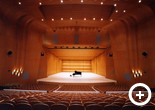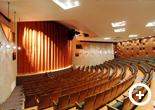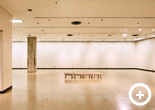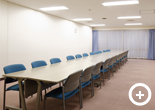- HOME
- VENUES
SAITAMA HALL
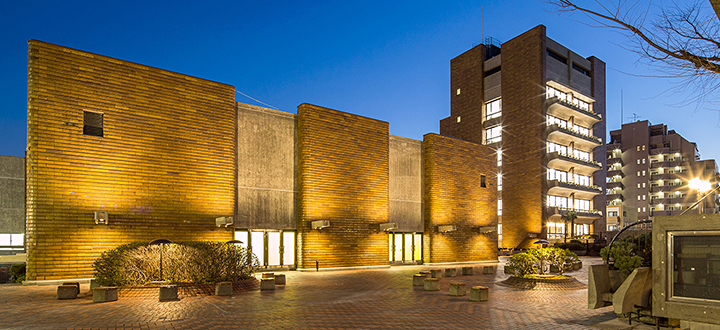
HISTORY AND ARCHITECTURE
HISTORY
The history of the SAITAMA HALL is largely divided into two; the original building born in 1926 as “SAITAMA HALL FOR COMMEMORATING EMPEROR SHOWA’S MARRIAGE”, and the current building rebuilt in 1966 as “THE SAITAMA HALL”. Since the original building has opened, SAITAMA HALL has been keeping its history for approximately 90 years as a center of culture in the community.
-
see more
open -
SAITAMA HALL FOR COMMEMORATING EMPEROR SHOWA’S MARRIAGE
The original Saitama Hall was planned to commemorate the marriage of the prince Hirohito (the future Emperor Showa) by Saitama prefecture.
The lack of funds because of the Great Kanto Earthquake postponed the construction planned in 1923, but Eiichi Shibusawa, widely known today as the father of Japanese capitalism, offered his contribution to the project. The construction restarted in 1925, and finally completed on Nov 6, 1926.
At the time in 1920s a public meeting facilities like SAITAMA HALL was unusual in JAPAN. Following the opening of Nippon-Seinenkan, SAITAMA HALL opened earlier than Hibiya Public Hall. The original building was designed by Shinichiro Okada whose major design works are Osaka Central Civic Hall (1917: an important cultural property), Kabukiza(1924), etc.
Designed by: Shinichiro Okada
The old building complex comprised two buildings: a main building and an annex, which had a classical flavor when viewed from today. In spite of its looks, it was fireproof and built strong enough to withstand earthquakes equivalent to the Great Kanto Earthquake. A bronze nameplate, placed at the entrance, displayed the name of building engraved in the handwriting of Mr. Shibusawa Eiichi, who had devoted himself to the construction of the hall. Its large assembly room was modeled in a very innovative style for Japan at that time. Great ingenuity was exercised in the design, allowing the audience to be able to see equally well from any seat, including the space that spread out toward the rear and its three-dimensional terraced style, providing a gradient. Meeting rooms and Japanese-style rooms were located in the annex, and a rooftop garden was in front of the Japanese rooms. A restaurant, a shop, and an entertainment room were in the basement.SAITAMA HALL
Because the original building which had been used for various meetings and events started to look decrepit, the expectation of renovation began to be heard after 30 years had passed since its completion in 1926. Aiming the building suitable for its profound history, the renovated SAITAMA HALL was designed by Kunio Maekawa, one of Japan’s great famous modern architects. The construction started in 1963, completed on Apr 18, and the hall opened on May 27, in 1966.
A lot of orchestra concerts were performed in Large Hall with excellent acoustics after its renovation.
You can find the atmosphere of its reopening in the film “Suna no Utsuwa- The Castle of Sand” (1974: directed by Yoshitaro Nomura) in which concert scene was filmed at the hall. The current SAITAMA HALL was built to embrace warmly the flow of people in the community. Answering to such concept of the architecture, it has been an oasis and a strolling place for many people.
Designed by Kunio Maekawa
The building that you are currently using is the SAITAMA HALL, renovated in 1966. The hall is designed by Mr. Kunio Maekawa, referred to as a great master of modern architecture in Japan. It has a large hall on the east side as well as a small hall and a meeting building on the west side, between which an esplanade is arranged through the spread of colorful tiles according to a unique method. The two-stage esplanade, made to mimic the shape of land differentiated elevation, was created by embedding 60% of the building in the basement. This esplanade is designed to accept a flow of people in a relaxed manner as an oasis and also as a strolling place, presenting a new way for public cultural facilities in urban areas to be. The outer wall of the building is covered with yellow-brown tiles, placed by the tile implantation method, which is a feature of Maekawa’s architecture. These tiles with a natural-baking unevenness and made of a fair-faced concrete, can be a partly glimpsed form of an exquisite contrast. Noncombustible plywood materials are used for the entire interior finish of the large hall, which has a reputation for good acoustics. These walls with their interior finish are integrated with the ceiling surface, which we can say is a very unusual structure compared with the typical present structures. Audience seats in the small hall are placed in a fan shape around the stage, highlighting their intimacy and unity with the stage. In addition, exhibition rooms and meeting rooms are also located here.
FLOOR MAP
-
FLOOR MAP
open -
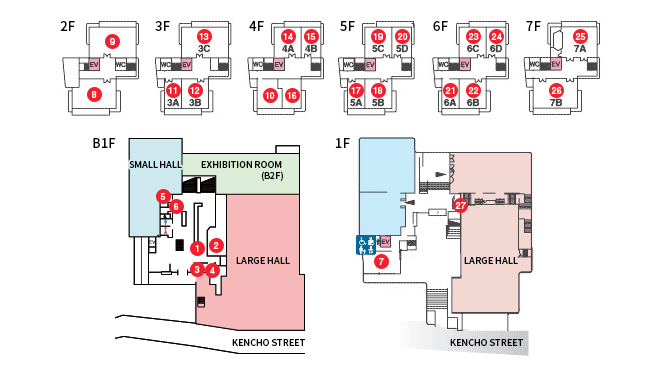
SAITAMA HALL
- ■ LARGE HALL
- ■ SMALL HALL
- ■ EXHIBITION ROOM
- 1 Information & Ticket office
- 2Reception & Administration office
- 3Security room(AED)
- 4First Aid room
- 5 nursery
- 6Nursing room
- 7 Restaurant
- 8Restaurant Banquet room
- 9 Lounge
- 10 JAPANESE ROOM
- 11~26 CONFERENCE ROOM
- 27Coin locker
ACCESS
ADDRESS
3-1-4 TAKASAGO, Urawa-ku, Saitama-shi, Saitama, 330-8518, JAPAN
TEL: +81-(0)48-829-2471 (9:00am-07:00pm)
MAP
ACCESS TO SAITAMA HALL
By Train
Urawa Station on JR Line (6-minute walk from the West Exit)
By Car
Turn to east on Kencho-mae crossing on Japan National Route 17, and proceed about 230m along the street. Hall is on the left side.
*Parking
Capacity: 39
Fee: 350 yen /1 hour
Height limit: 2m
Visitors are advised to use public transportation due to limited availability.
VENUE OUTLINE
Name: Saitama Hall
Address: 3-1-4 Takasago, Urawa-ku, Saitama-shi, Saitama
TEL. +81-(0)48-829-2471
Designated Administrator: Saitama Arts Foundation
Design and Planning: MAEKAWA ASSOCIATES, ARCHITECTS & ENGINEERS
Structure: Steel-skeleton reinforced concrete (SRC)
Seven stories above ground and three below
Building area: 4,164.7 sq. meters
Total area: 18,414.5 sq. meters
Constructed: Dec 17, 1963 – Apr 18, 1966
Opening: May 27, 1966
HOW TO BUY TICKETS
ticket information HOW TOBUY TICKETS
EVENT CALENDAR
SAITAMA ARTS THEATER
CLOSED
SAITAMA ARTS THEATER
2025
| APR | 7・14・21 |
|---|---|
| MAY | 19・26 |
| JUN | 2・23・24・30 |
| JUL | 7・14 |
| AUG | 12・18・25 |
| SEP | 8・16・29 |
| OCT | 6・14・20 |
| NOV | 4・10・17・18・25 |
| DEC | 8・15・29・30・31 |
2026
| JAN | 1・2・3・19・26 |
|---|---|
| FEB | 2・9・16・24 |
| MAR | 9・16・23 |
SAITAMA HALL
2025
| APR | 16 |
|---|---|
| MAY | 14 |
| JUN | 10・11 |
| JUL | 9 |
| AUG | 13 |
| SEP | 10 |
| OCT | 8 |
| NOV | 12 |
| DEC | 9・10・15・29・30・31 |
2026
| JUN | 1・2・3・15 |
|---|---|
| FEB | 18 |
| MAR | 11 |


